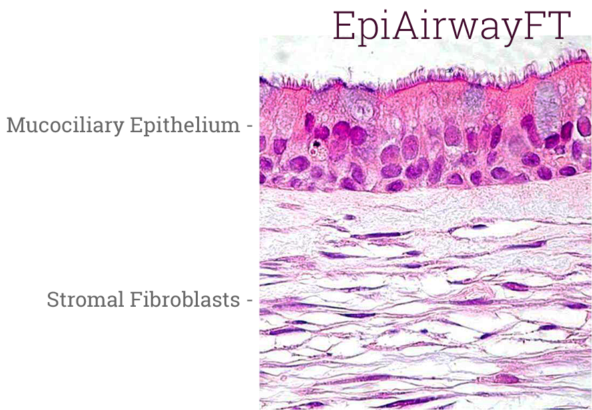Overview
The human 3D in vitro respiratory tissue model developed by MatTek is changing preclinical testing in toxicology, viral research, inflammation and fibrosis, and drug development.
MatTek’s 3D tissue models of the human airway are helping to advance in vitro respiratory studies all over the world. EpiAirway’s human-relevant biological reactions, which allow for physiological exposures to pathogens, chemicals, or therapeutics, are revolutionizing the way scientists study respiratory disorders and drug development.
Features
- Produced from healthy or diseased primary human cells
- Mucociliary differentiation
- 30+ donors available
- Delivered ready-to-use

Image Credit: MatTek
Technology

Image Credit: MatTek
EpiAirway is a 3D mucociliary tissue model that is ready-to-use and made out of normal, human-derived tracheal/bronchial epithelial cells. It is also obtainable as a co-culture system with normal human stromal fibroblasts (EpiAirwayFT).
EpiAirway, which is cultured at the air-liquid interface (ALI), mimics the in vivo phenotypes of barrier, mucociliary responses, infection, toxicity responses, and disease. EpiAirway is suited to acute or long-term chronic research spanning a wide range of highly predictive in vitro applications, with over 100 technical references accessible.

EpiAirway at 6 weeks in culture. Image Credit: MatTek
EpiAirway has high uniformity and reproducibility in human-relevant tissue structure and cellular morphology. Its 3D structure is made up of Keratin 5+ basal cells that are structured, mucus-producing goblet cells, functional tight junctions, and beating cilia. EpiAirwayFT contains human fibroblasts in an extracellular stromal matrix that is appropriate for research on inflammation and fibrosis.

Image Credit: MatTek
Human relevance
EpiAirway’s mucociliary 3D tissue structure, cultured at the Air-liquid Interface, provides for human relevant exposure to test items.
The EpiAirway 3D human tissue model is commonly used for safety and risk evaluation, anti-viral research, inflammation and fibrosis, and drug administration. Scientists can collect data in days rather than weeks or months because of simple protocols and the examination of early cellular endpoints.
Applications
Virus infection
EpiAirway can be used to investigate respiratory virus attachment, replication, innate immune responses, and the development of antiviral drugs.
Drug delivery
To measure API penetration and flux, use existing transdermal permeation equipment or MatTek’s simple single insert permeation devices.
Inhalation toxicology
The EpiAirway IC-75 assay (available in different formats for physiological exposure systems) can be used to establish relative safety.
Inflammation and fibrosis
To unravel molecular pathways and measure therapeutic efficacy, use EpiAirway's diverse donor inventory of healthy and diseased donors (Asthma, COPD, Smoker, Goblet Cell Hyperplasia).